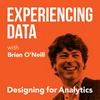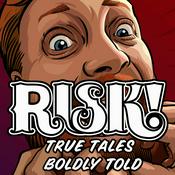116 episódios

185 - Driving Healthcare Impact by Aligning Teams Around Outcomes with Bill Saltmarsh
23/12/2025 | 41min
Bill Saltmarsh joins me to discuss where a modern CDO gets the inspiration to “operate in the producty way” in his domain, which is healthcare. Now Vice President of Enterprise Data and Transformation and the Chief Data Officer at Children’s Mercy Kansas City, his early days as an analyst revealed a gap between what stakeholders asked for vs. the outcomes they sought. This convinced him that data teams need to pause, ask better questions, and prioritize meaningful outcomes over quickly churning out dashboards and reports. Bill and I discuss how a producty mindset can be embedded across an organization. He also talks about why data leaders must set firm expectations. We explore the personal and cultural shifts needed for analysts and data scientists to embrace design, facilitation, and deeper discovery, even when it initially seems to slow things down. We also examine how to define value and ROI in healthcare, where a data team's impact is often indirect. By tying data efforts to organizational OKRs and investing in governance, strong data foundations, and data literacy, he argues that analytics, data, and AI can drive better decisions, enhance patient care, and create durable organizational value. Highlights/ Skip to: What led Bill Saltmarsh to run his team at Children’s Mercy “the producty way” (1:42) The kinds of environments Bill worked in prior that influenced his current management philosophy (4:36) Why data teams shouldn’t be report factories (6:37) Setting the standard at the leadership level vs the everyday work (10:53) How Bill is skilling and hiring for non-technical skills (i.e. product, design, etc) (13:51) Patterns that data professionals go through to know if they’re guiding stakeholders correctly (20:54) The point when Bill has to think about the financial side of the hospital (26:30) How Bill thinks about measuring the data team’s contributions to the hospital’s success (30:28) Bill’s philosophy on generative AI (36:00) Links Bill Saltmarsh on LinkedIn

184 - Part III: Designing with the Flow of Work: Accelerating Sales in B2B Analytics and AI Products by Minimizing Behavior Change
09/12/2025 | 14min
In this final part of my three-episode series on accelerating sales and adoption in B2B analytics and AI products, I unpack a growing challenge in the age of generative AI: what to do when your product automates a major chunk of a user’s workflow only to reveal an entirely new problem right behind it. Building on Part I and Part II, I look at how AI often collapses the “front half” of a process, pushing the more complex, value-heavy work directly to users. This raises critical questions about product scope, market readiness, competitive risks, and whether you should expand your solution to tackle these newly surfaced problems or stay focused and validate what buyers will actually pay for. I also discuss why achieving customer delight—not mere satisfaction—is essential for earning trust, reducing churn, and creating the conditions where customers become engaged design partners. Finally, I highlight the common pitfalls of DIY product design and why intentional, validated UX work is so important, especially when AI is changing how work gets done faster than ever. Highlights/ Skip to: Finishing the journey: staying focused, delighting users, and intentional UX (00:35) AI solves problems—and can create new ones for your customers—now what? (2:17) Do AI products have to solve your customers’ downstream “tomorrow” problems too before they’ll pay? (6:24) Questions that reveal whether buyers will pay for expanded scope (6:45) UX outcomes: moving customers from satisfied to delighted before tackling new problems (8:11) How obtaining “delight” status in the customer’s mind creates trust, lock-in, and permission to build the next solution (9:54) Designing experiences with intention (not hope) as AI changes workflows (10:40) My “Ten Risks of DIY Product Design…” — why DIY UX often causes self-inflicted friction (11:46) Links Listen to part I: Episode 182 and part two: Episode 183 Read: “Ten Risks of DIY Product Design On Sales And Adoption Of B2B Data Products” Stop guessing what is blocking your own product’s adoption and sales: Schedule a Design-Eyes Assessment with me, and in 90 minutes, I'll diagnose whether you're facing a design problem, a product management gap, a positioning issue, or something else entirely. You'll walk away knowing exactly what's standing between your product and the traction you need—so you don't waste time and money on product design "improvements" that won't move your critical KPIs.

183 - Part II: Designing with the Flow of Work: Accelerating Sales in B2B Analytics and AI Products by Minimizing Behavior Change
27/11/2025 | 35min
In this second part of my three-part series (catch Part I via episode 182), I dig deeper into the key idea that sales in commercial data products can be accelerated by designing for actual user workflows—vs. going wide with a “many-purpose” AI and analytics solution that “does more,” but is misaligned with how users’ most important work actually gets done. To explain this, I will explain the concept of user experience (UX) outcomes, and how building your solution to enable these outcomes may be a dependency for you to get sales traction, and for your customer to see the value of your solution. I also share practical steps to improve UX outcomes in commercial data products, from establishing a baseline definition of UX quality to mapping out users’ current workflows (and future ones, when agentic AI changes their job). Finally, I talk about how approaching product development as small “bets” helps you build small, and learn fast so you can accelerate value creation. Highlights/ Skip to: Continuing the journey: designing for users, workflows, and tasks (00:32) How UX impacts sales—not just usage and adoption(02:16) Understanding how you can leverage users’ frustrations and perceived risks as fuel for building an indispensable data product (04:11) Definition of a UX outcome (7:30) Establishing a baseline definition of product (UX) quality, so you know how to observe and measure improvement (11:04 ) Spotting friction and solving the right customer problems first (15:34) Collecting actionable user feedback (20:02) Moving users along the scale from frustration to satisfaction to delight (23:04) Unique challenges of designing B2B AI and analytics products used for decision intelligence (25:04) Quotes from Today’s Episode One of the hardest parts of building anything meaningful, especially in B2B or data-heavy spaces, is pausing long enough to ask what the actual ‘it’ is that we’re trying to solve. People rush into building the fix, pitching the feature, or drafting the roadmap before they’ve taken even a moment to define what the user keeps tripping over in their day-to-day environment. And until you slow down and articulate that shared, observable frustration, you’re basically operating on vibes and assumptions instead of behavior and reality. What you want is not a generic problem statement but an agreed-upon description of the two or three most painful frictions that are obvious to everyone involved, frictions the user experiences visibly and repeatedly in the flow of work. Once you have that grounding, everything else prioritization, design decisions, sequencing, even organizational alignment suddenly becomes much easier because you’re no longer debating abstractions, you’re working against the same measurable anchor. And the irony is, the faster you try to skip this step, the longer the project drags on, because every downstream conversation becomes a debate about interpretive language rather than a conversation about a shared, observable experience. __ Want people to pay for your product? Solve an *observable* problem—not a vague information or data problem. What do I mean? “When you’re trying to solve a problem for users, especially in analytical or AI-driven products, one of the biggest traps is relying on interpretive statements instead of observable ones. Interpretive phrasing like ‘they’re overwhelmed’ or ‘they don’t trust the data’ feels descriptive, but it hides the important question of what, exactly, we can see them doing that signals the problem. If you can’t film it happening, if you can’t watch the behavior occur in real time, then you don’t actually have a problem definition you can design around. Observable frustration might be the user jumping between four screens, copying and pasting the same value into different systems, or re-running a query five times because something feels off even though they can’t articulate why. Those concrete behaviors are what allow teams to converge and say, ‘Yes, that’s the thing, that is the friction we agree must change,’ and that shift from interpretation to observation becomes the foundation for better design, better decision-making, and far less wasted effort. And once you anchor the conversation in visible behavior, you eliminate so many circular debates and give everyone, from engineering to leadership, a shared starting point that’s grounded in reality instead of theory." __ One of the reasons that measuring the usability/utility/satisfaction of your product’s UX might seem hard is that you don’t have a baseline definition of how satisfactory (or not) the product is right now. As such, it’s very hard to tell if you’re just making product *changes*—or you’re making *improvements* that might make the product worth paying for at all, worth paying more for, or easier to buy. "It’s surprisingly common for teams to claim they’re improving something when they’ve never taken the time to document what the current state even looks like. If you want to create a meaningful improvement, something a user actually feels, you need to understand the baseline level of friction they tolerate today, not what you imagine that friction might be. Establishing a baseline is not glamorous work, but it’s the work that prevents you from building changes that make sense on paper but do nothing to the real flow of work. When you diagram the existing workflow, when you map the sequence of steps the user actually takes, the mismatches between your mental model and their lived experience become crystal clear, and the design direction becomes far less ambiguous. That act of grounding yourself in the current state allows every subsequent decision, prioritizing fixes, determining scope, measuring progress, to be aligned with reality rather than assumptions. And without that baseline, you risk designing solutions that float in conceptual space, disconnected from the very pains you claim to be addressing." __ Prototypes are a great way to learn—if you’re actually treating them as a means to learn, and not a product you intend to deliver regardless of the feedback customers give you. "People often think prototyping is about validating whether their solution works, but the deeper purpose is to refine the problem itself. Once you put even a rough prototype in front of someone and watch what they do with it, you discover the edges of the problem more accurately than any conversation or meeting can reveal. Users will click in surprising places, ignore the part you thought mattered most, or reveal entirely different frictions just by trying to interact with the thing you placed in front of them. That process doesn’t just improve the design, it improves the team’s understanding of which parts of the problem are real and which parts were just guesses. Prototyping becomes a kind of externalization of assumptions, forcing you to confront whether you’re solving the friction that actually holds back the flow of work or a friction you merely predicted. And every iteration becomes less about perfecting the interface and more about sharpening the clarity of the underlying problem, which is why the teams that prototype early tend to build faster, with better alignment, and far fewer detours." __ Most founders and data people tend to measure UX quality by “counting usage” of their solution. Tracking usage stats, analytics on sessions, etc. The problem with this is that it tells you nothing useful about whether people are satisfied (“meets spec”) or delighted (“a product they can’t live without”). These are product metrics—but they don’t reflect how people feel. There are better measurements to use for evaluating users’ experience that go beyond “willingness to pay.” Payment is great, but in B2B products, buyers aren’t always users—and we’ve all bought something based on the promise of what it would do for us, but the promise fell short. "In B2B analytics and AI products, the biggest challenge isn’t complexity, it’s ambiguity around what outcome the product is actually responsible for changing. Teams often define success in terms of internal goals like ‘adoption,’ ‘usage,’ or ‘efficiency,’ but those metrics don’t tell you what the user’s experience is supposed to look like once the product is working well. A product tied to vague business outcomes tends to drift because no one agrees on what the improvement should feel like in the user’s real workflow. What you want are visible, measurable, user-centric outcomes, outcomes that describe how the user’s behavior or experience will change once the solution is in place, down to the concrete actions they’ll no longer need to take. When you articulate outcomes at that level, it forces the entire organization to align around a shared target, reduces the scope bloat that normally plagues enterprise products, and gives you a way to evaluate whether you’re actually removing friction rather than just adding more layers of tooling. And ironically, the clearer the user outcome is, the easier it becomes to achieve the business outcome, because the product is no longer floating in abstraction, it’s anchored in the lived reality of the people who use it." Links Listen to part one: Episode 182 Schedule a Design-Eyes Assessment with me and get clarity, now.

182 - Designing with the Flow of Work: Accelerating Sales in B2B Analytics and AI Products by Minimizing Behavior Change
10/11/2025 | 22min
Building B2B analytics and AI tools that people will actually pay for and use is hard. The reality is, your product won’t deliver ROI if no one’s using it. That’s why first principles thinking says you have to solve the usage problem first. In this episode, I’ll explain why the key to user adoption is designing with the flow of work—building your solution around the natural workflows of your users to minimize the behavior changes you’re asking them to make. When users clearly see the value in your product, it becomes easier to sell and removes many product-related blockers along the way. We’ll explore how product design impacts sales, the difference between buyers and users in enterprise contexts, and why challenging the “data/AI-first” mindset is essential. I’ll also share practical ways to align features with user needs, reduce friction, and drive long-term adoption and impact. If you’re ready to move beyond the dashboard and start building products that truly fit the way people work, this episode is for you. Highlights/Skip to: The core argument: why solving for user adoption first helps demonstrate ROI and facilitate sales in B2B analytics and AI products (1:34) How showing the value to actual end users—not just buyers—makes it easier to sell your product (2:33) Why designing for outcomes instead of outputs (dashboards, etc) leads to better adoption and long-term product value (8:16) How to “see” beyond users’ surface-level feature requests and solutions so you can solve for the actual, unspoken need—leading to an indispensable product (10:23) Reframing feature requests as design-actionable problems (12:07) Solving for unspoken needs vs. customer-requested features and functions (15:51) Why “disruption” is the wrong approach for product development (21:19) Quotes: “Customers’ tolerance for poorly designed B2B software has decreased significantly over the last decade. People now expect enterprise tools to function as smoothly and intuitively as the consumer apps they use every day. Clunky software that slows down workflows is no longer acceptable, regardless of the data it provides. If your product frustrates users or requires extra effort to achieve results, adoption will suffer. Even the most powerful AI or analytics engine cannot compensate for a confusing or poorly structured interface. Enterprises now demand experiences that are seamless, efficient, and aligned with real workflows. This shift means that product design is no longer a secondary consideration; it is critical to commercial success. Founders and product leaders must prioritize usability, clarity, and delight in every interaction. Software that is difficult to use increases the risk of churn, lengthens sales cycles, and diminishes perceived value. Products must anticipate user needs and deliver solutions that integrate naturally into existing workflows. The companies that succeed are the ones that treat user experience as a strategic differentiator. Ignoring this trend creates friction, frustration, and missed opportunities for adoption and revenue growth. Design quality is now inseparable from product value and market competitiveness. The message is clear: if you want your product to be adopted, retain customers, and win in the market, UX must be central to your strategy.” — “No user really wants to ‘check a dashboard’ or use a feature for its own sake. Dashboards, charts, and tables are outputs, not solutions. What users care about is completing their tasks, solving their problems, and achieving meaningful results. Designing around workflows rather than features ensures your product is indispensable. A workflow-first approach maps your solution to the actual tasks users perform in the real world. When we understand the jobs users need to accomplish, we can build products that deliver real value and remove friction. Focusing solely on features or data can create bloated products that users ignore or struggle to use. Outputs are meaningless if they do not fit into the context of a user’s work. The key is to translate user needs into actionable workflows and design every element to support those flows. This approach reduces cognitive load, improves adoption, and ensures the product's ROI is realized. It also allows you to anticipate challenges and design solutions that make workflows smoother, faster, and more efficient. By centering design on actual tasks rather than arbitrary metrics, your product becomes a tool users can’t imagine living without. Workflow-focused design directly ties to measurable outcomes for both end users and buyers. It shifts the conversation from features to value, making adoption, satisfaction, and revenue more predictable.” — “Just because a product is built with AI or powerful data capabilities doesn’t mean anyone will adopt it. Long-term value comes from designing solutions that users cannot live without. It’s about creating experiences that take people from frustration to satisfaction to delight. Products must fit into users’ natural workflows and improve their performance, efficiency, and outcomes. Buyers' perceived ROI is closely tied to meaningful adoption by end users. If users struggle, churn rises, and financial impact is diminished, regardless of technical sophistication. Designing for delight ensures that the product becomes a positive force in the user’s daily work. It strengthens engagement, reduces friction, and builds customer loyalty. High-quality UX allows the product to demonstrate value automatically, without constant explanations or hand-holding. Delightful experiences encourage advocacy, referrals, and easier future sales. The real power of design lies in aligning technical capabilities with human behavior and workflow. When done correctly, this approach transforms a tool into an indispensable part of the user’s job and a demonstrable asset for the business. Focusing on usability, satisfaction, and delight creates long-term adoption and retention, which is the ultimate measure of product success.” — “Your product should enter the user’s work stream like a raft on a river, moving in the same direction as their workflow. Users should not have to fight the current or stop their flow to use your tool. Introducing friction or requiring users to change their behavior increases risk, even if the product delivers ROI. The more naturally your product aligns with existing workflows, the easier it is to adopt and the more likely it is to be retained. Products that feel intuitive and effortless become indispensable, reducing conversations about usability during demos. By matching the flow of work, your solution improves satisfaction, accelerates adoption, and enhances perceived value. Disrupting workflows without careful observation can create new problems, frustrate users, and slow down sales. The goal is to move users from frustration to satisfaction to delight, all while achieving the intended outcomes. Designing with the flow of work ensures that every feature, interface element, and interaction fits seamlessly into the tasks users already perform. It allows users to focus on value instead of figuring out how to use the product. This alignment is key to unlocking adoption, retaining customers, and building long-term loyalty. Products that resist the natural workflow may demonstrate ROI on paper but fail in practice due to friction and low engagement. Success requires designing a product that supports the user’s journey downstream without interruption or extra effort. When you achieve this, adoption becomes easier, sales conversations smoother, and long-term retention higher.” —

181 - Lessons Learned Designing Orion, Gravity’s AI, AI Analyst Product with CEO Lucas Thelosen (former Head of Product @ Google Data & AI Cloud)
28/10/2025 | 50min
On today's Promoted Episode of Experiencing Data, I’m talking with Lucas Thelosen, CEO of Gravity and creator of Orion, an AI analyst transforming how data teams work. Lucas was head of PS for Looker, and eventually became Head of Product for Google’s Data and AI Cloud prior to starting his own data product company. We dig into how his team built Orion, the challenge of keeping AI accurate and trustworthy when doing analytical work, and how they’re thinking about the balance of human control with automation when their product acts as a force multiplier for human analysts. In addition to talking about the product, we also talk about how Gravity arrived at specific enough use cases for this technology that a market would be willing to pay for, and how they’re thinking about pricing in today’s more “outcomes-based” environment. Incidentally, one thing I didn’t know when I first agreed to consider having Gravity and Lucas on my show was that Lucas has been a long-time proponent of data product management and operating with a product mindset. In this episode, he shares the “ah-hah” moment where things clicked for him around building data products in this manner. Lucas shares how pivotal this moment was for him, and how it helped accelerate his career from Looker to Google and now Gravity. If you’re leading a data team, you’re a forward-thinking CDO, or you’re interested in commercializing your own analytics/AI product, my chat with Lucas should inspire you! Highlights/ Skip to: Lucas’s breakthrough came when he embraced a data product management mindset (02:43) How Lucas thinks about Gravity as being the instrumentalists in an orchestra, conducted by the user (4:31) Finding product-market fit by solving for a common analytics pain point (8:11) Analytics product and dashboard adoption challenges: why dashboards die and thinking of analytics as changing the business gradually (22:25) What outcome-based pricing means for AI and analytics (32:08) The challenge of defining guardrails and ethics for AI-based analytics products [just in case somebody wants to “fudge the numbers”] (46:03) Lucas’ closing thoughts about what AI is unlocking for analysts and how to position your career for the future (48:35) Special Bonus for DPLC Community Members Are you a member of the Data Product Leadership Community? After our chat, I invited Lucas to come give a talk about his journey of moving from “data” to “product” and adopting a producty mindset for analytics and AI work. He was more than happy to oblige. Watch for this in late 2025/early 2026 on our monthly webinar and group discussion calendar. Note: today’s episode is one of my rare Promoted Episodes. Please help support the show by visiting Gravity’s links below: Quotes from Today’s Episode “The whole point of data and analytics is to help the business evolve. When your reports make people ask new questions, that’s a win. If the conversations today sound different than they did three months ago, it means you’ve done your job, you’ve helped move the business forward.” — Lucas “Accuracy is everything. The moment you lose trust, the business, the use case, it's all over. Earning that trust back takes a long time, so we made accuracy our number one design pillar from day one.” — Lucas “Language models have changed the game in terms of scale. Suddenly, we’re facing all these new kinds of problems, not just in AI, but in the old-school software sense too. Things like privacy, scalability, and figuring out who’s responsible.” — Brian “Most people building analytics products have never been analysts, and that’s a huge disadvantage. If data doesn’t drive action, you’ve missed the mark. That’s why so many dashboards die quickly.” — Lucas “Re: collecting feedback so you know if your UX is good: I generally agree that qualitative feedback is the best place to start, not analytics [on your analytics!] Especially in UX, analytics measure usage aspects of the product, not the subject human experience. Experience is a collection of feelings and perceptions about how something went.” — Brian Links Gravity: https://www.bygravity.com LinkedIn: https://www.linkedin.com/in/thelosen/ Email Lucas and team: [email protected]
Mais podcasts de Arte
Podcasts em tendência em Arte
Sobre Experiencing Data w/ Brian T. O’Neill (AI & data product management leadership—powered by UX design)
Ouça Experiencing Data w/ Brian T. O’Neill (AI & data product management leadership—powered by UX design), Rádio Companhia e muitos outros podcasts de todo o mundo com o aplicativo o radio.net

Obtenha o aplicativo gratuito radio.net
- Guardar rádios e podcasts favoritos
- Transmissão via Wi-Fi ou Bluetooth
- Carplay & Android Audo compatìvel
- E ainda mais funções
Obtenha o aplicativo gratuito radio.net
- Guardar rádios e podcasts favoritos
- Transmissão via Wi-Fi ou Bluetooth
- Carplay & Android Audo compatìvel
- E ainda mais funções


Experiencing Data w/ Brian T. O’Neill (AI & data product management leadership—powered by UX design)
baixe o aplicativo,
ouça.





























